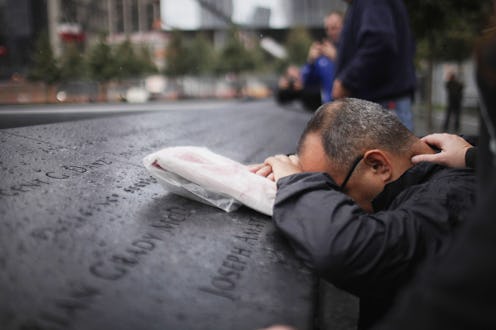News
What The 9/11 Museum's First Visitors Experienced
On Wednesday, the 9/11 Museum opened to the public following years of delays from flooding, funding issues, and building problems. Surrounded by trees and flanked by the 9/11 Memorial of cascading water, the 9/11 Museum opened for the first time at 8:30 a.m., and for many guests, the complete visit took around two hours. Ann Stanislaus, a native New Yorker, told Bustle the experience was a "wonderful tribute to the people who have passed away and all the hard work of the people who tried to save their lives."
Not only did it memorialize those who lost their lives in the 2001 attacks, Stanislaud continued, but it also served as a "tribute to life."
Stanislaus, who was at work in Rochester on September 11, remembers returning to the city from upstate New York and coming across a sign that read: "New York is closed." As she re-entered the city, a place where she'd always heard "horns blaring, all noise," she heard nothing but silence.
More than a decade later, Stanislaus felt a tremendous surge of pride and respect as she returned to the site of what was once great destruction. The most moving part for her was ascending the escalators to the exit, which Stanislaus said felt like "ascending into heaven."
For others, the most poignant part of the museum came with the personal artifacts and recordings of those who lost their lives. Shannon Bailey, who was working in New York on 9/11, spoke to Bustle about the audio recordings obtained from the wreckage of Flight 93 — which brave passengers managed to divert from Washington, D.C., and instead crashed in a field in Pennsylvania. "It was a very intense experience," Bailey said. "Beautifully put together."
For Bailey's friend Halina Avery, the museum reminded her of the incredible humanity shone through in the victims' last moments. In one section of the museum, Avery said, "You can walk behind a wall and see pictures of people jumping off the building, falling, and there are a couple quotes that are incredibly eloquent from [other] people." One man, Avery recalls, speaks of "watching a woman who fixed her skirt before jumping... how modest and human that was."
But there was one aspect of the museum that drew criticism from some visitors: The Al Qaeda exhibit. Gabriel Benroth, who visited with friends Bailey and Avery, said that while it was an "important" part of the museum, he felt as though "there needed to be pauses to reset yourself or choose whether to participate." Said Benroth, "It felt [as though]... you had to follow this story, and you couldn't find your own story."
And for many viewers, their own narrative wasn't prepared to include Al Qaeda in their remembrance of 9/11. Avery said that she was unable to "go beyond the grief... to think about what we could do" with the Al Qaeda exhibit. Bailey agreed, telling Bustle: "I avoided it. I didn't want to give them any attention."
And for one historian who visited the museum on Wednesday, this lack of attention is problematic. Todd Fine, a co-founder of the Save Washington Street effort and the founder and director of Project Khalid, told Bustle he took issue with how that the origins and motivations of Al Qaeda were described. While he said he found the experience "emotionally overwhelming," Fine said the museum begins the journey using the term "Islamism," and doesn't explain what the term means until much later — two hours later, for Fine himself.
Fine's major concern with what he believes is an insufficient explanation of Al Qaeda is how children will perceive the exhibit. "If young people are given an incomplete or even incorrect understanding of Islam," Fine explained, "this could hinder steps towards understanding other cultures."
